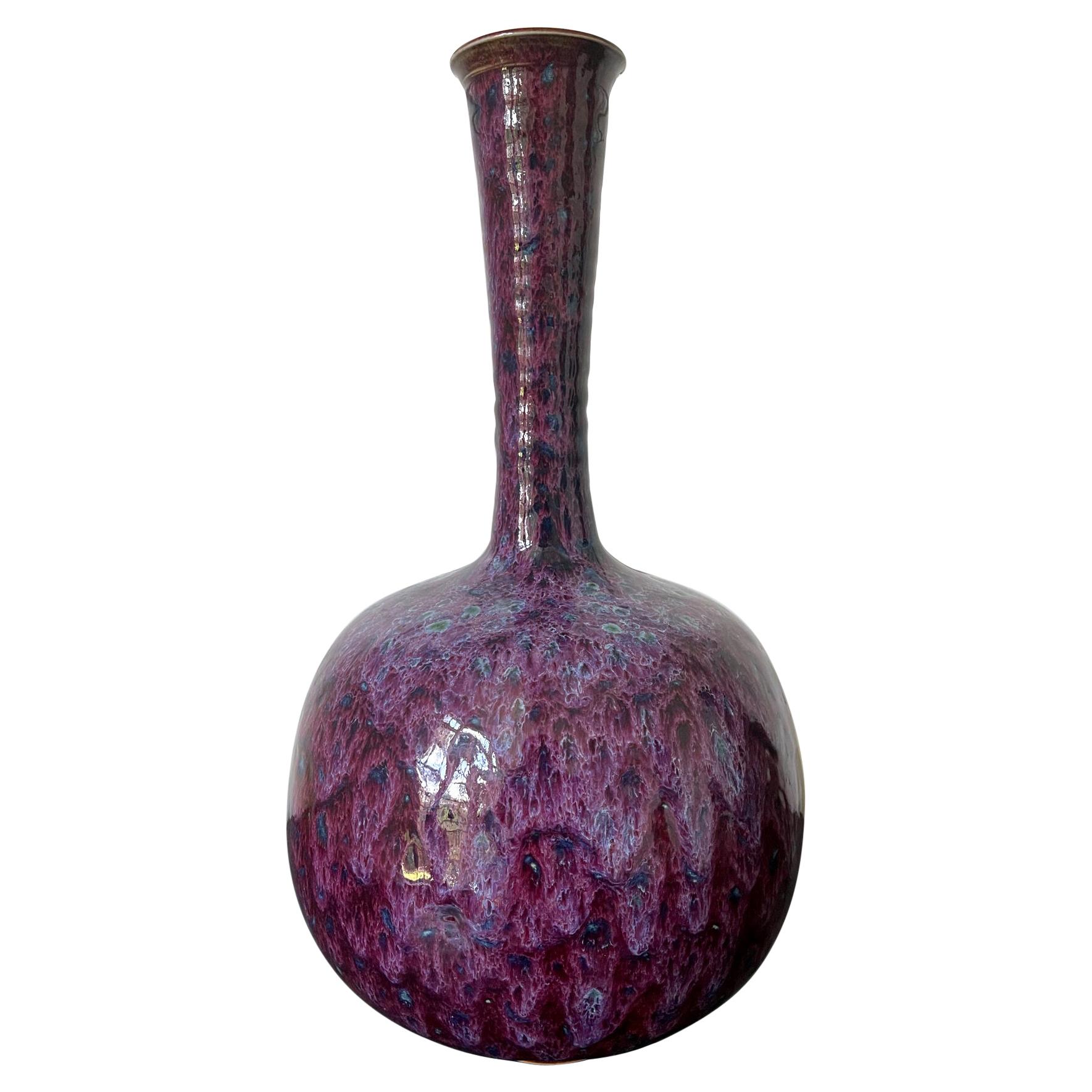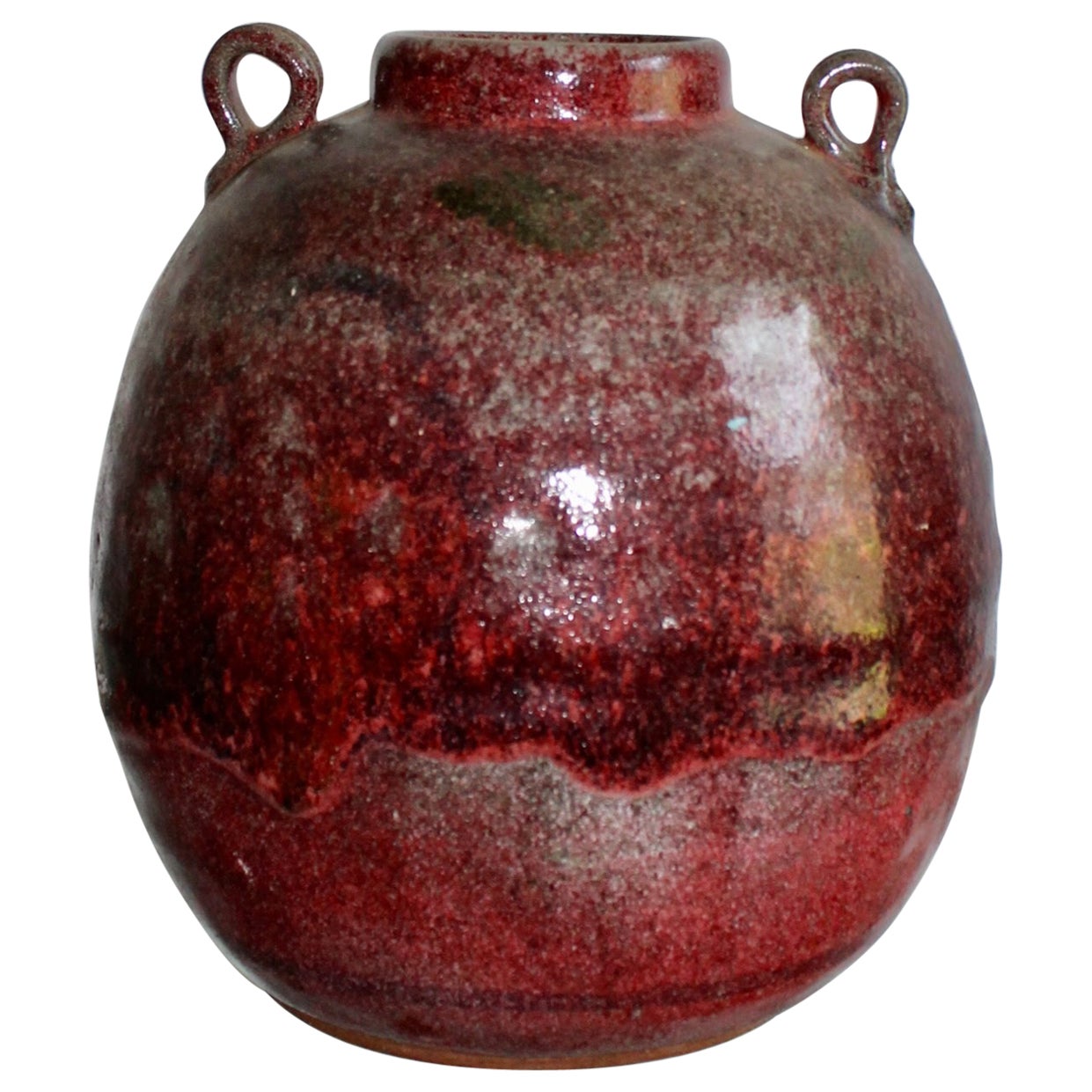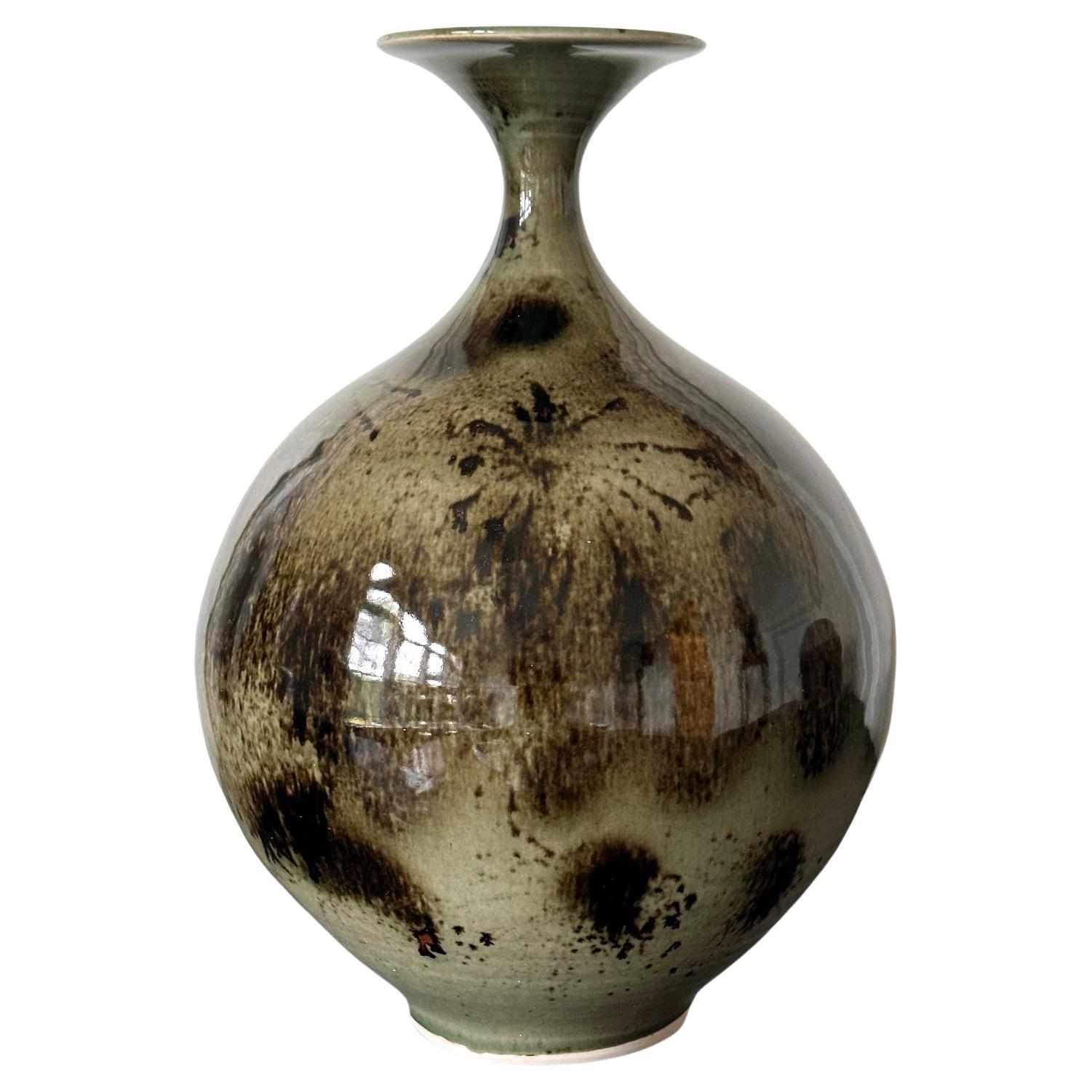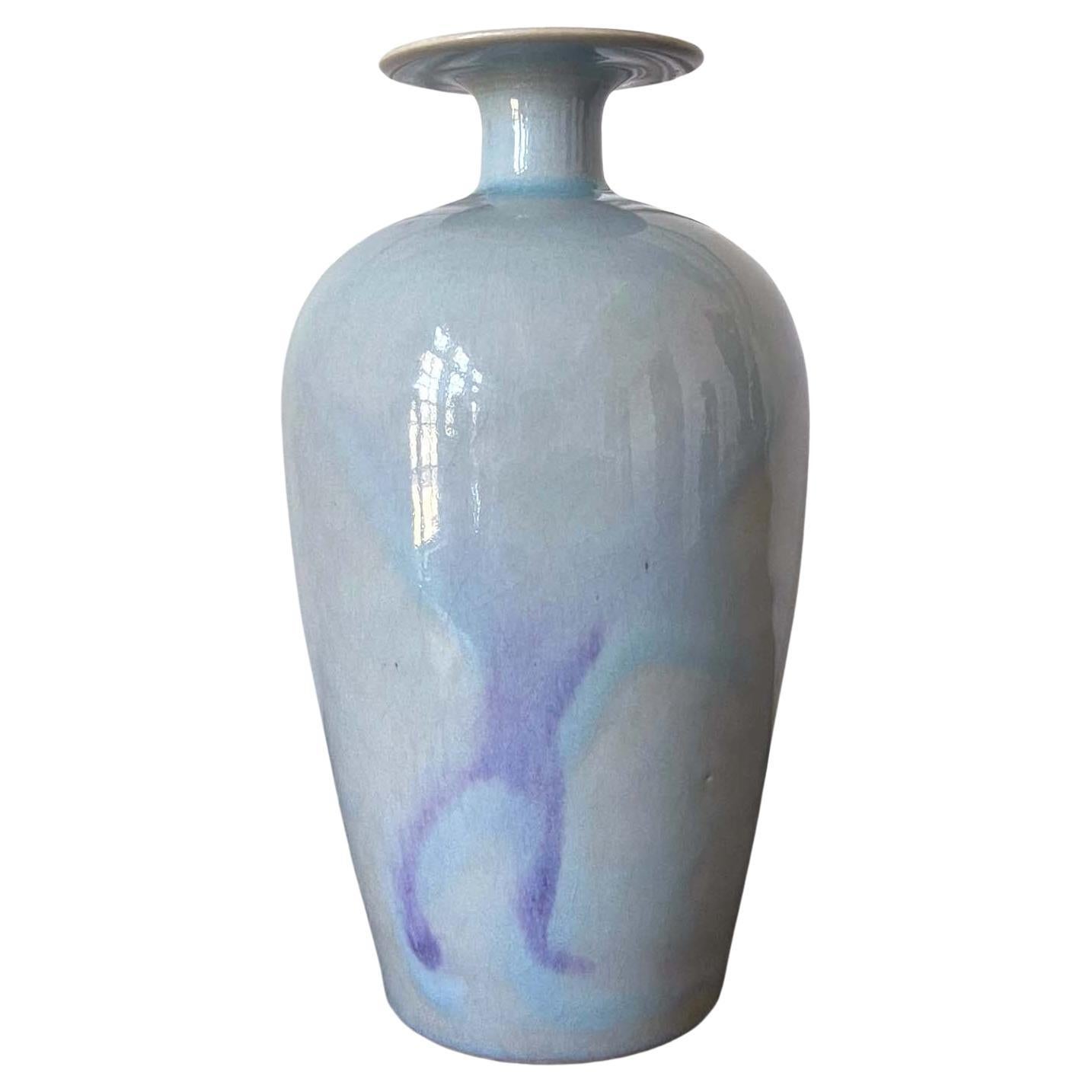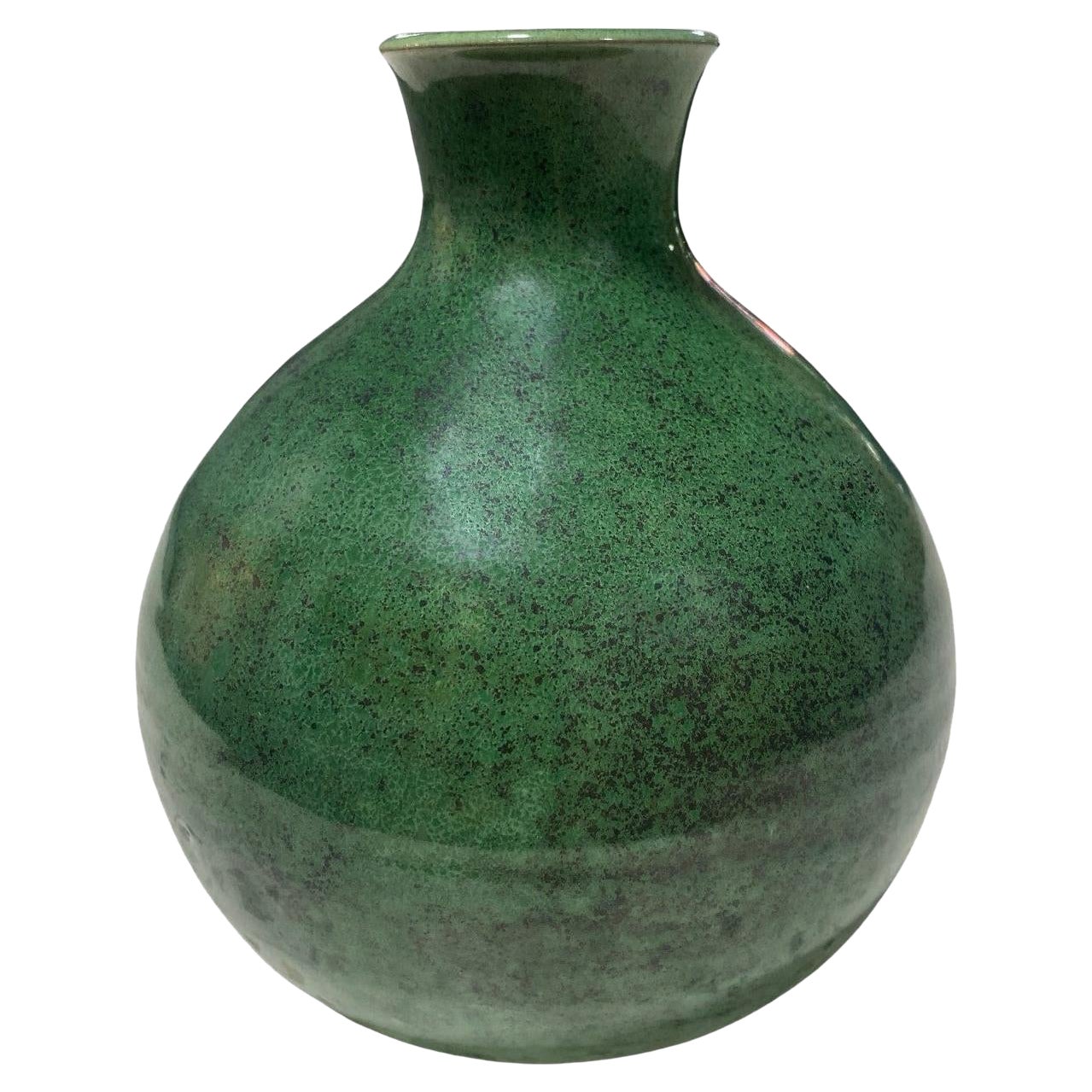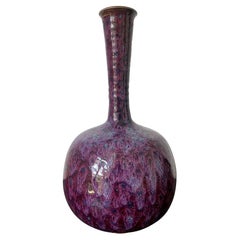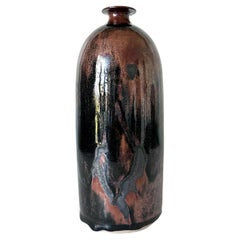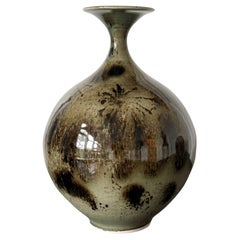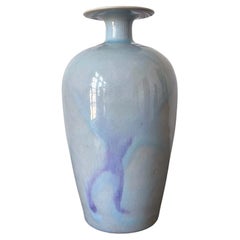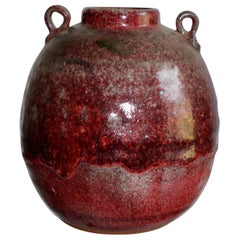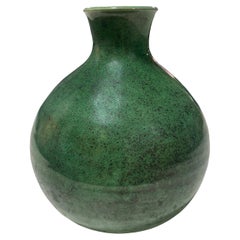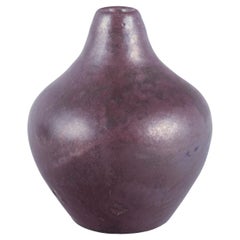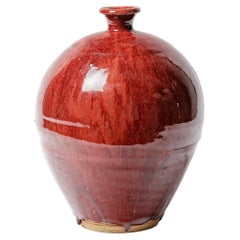Items Similar to Early Large Ceramic Vase with Sang-de-boeuf Glaze by Brother Thomas Bezanson
Want more images or videos?
Request additional images or videos from the seller
1 of 17
Early Large Ceramic Vase with Sang-de-boeuf Glaze by Brother Thomas Bezanson
$16,000
£12,158.92
€13,993.99
CA$22,896.81
A$25,157.04
CHF 12,973.32
MX$301,406.75
NOK 164,721.27
SEK 154,584.22
DKK 104,515.52
About the Item
An early ceramic long-neck vase with a brilliant copper red glaze by Benedictine monk potter Brother Thomas Bezanson (1929-2007). The minimalistic and harmonious form with a bulbous body was unmistakably informed by Asian silouette. What is extraordinary about this piece is not only its large size, but also the copper red glaze Bezanson achieved on the surface. Known as Ruby Red in Qing dynasty during K'ang Hsi reign (1662-1722), as an attempt to revive the then lost red ware in Ming Dynasty, the glaze was notoriously challenging for the potters. Named by "Sang-de-Boeuf" by French, the glaze has fascinated artists and collectors in both East and West for centuries. Celebrated for his tireless pursuit of perfection, Bezanson achieved a spectacular glaze effect on this vase. The copper red glaze radiates a jewel tone and upon closer inspection, specks of purple color from kiln transformation seep to the surface, feature-like. The glaze pools along the unglazed base, which was marked ''Benedictine Monks, Weston Vermont'' and artist decipher, dating the piece to circa 1965-1970. Probably one of the most difficult pieces with its large form and copper glaze combination, it may be considered by the artist humbly as "a piece that cannot be planned, it just happened", but it well demonstrates the highly sophisticated techniques Bezanson used fluidly in his work.
Brother Thomas Bezanson (1929-2007) was a Canadian born artist and Benedictine monk primarily known for his porcelain pottery and mastery of complex glazes. Strongly influenced by Asian pottery, often adapting traditional Chinese and Japanese pottery methods and materials to his work. He is renowned for his original glaze recipes and perfect forms and always sought to create something new and beautiful. His exacting standards made for the shattering of over 80% of each firing. One "rescued" piece however is now in the collection of the Museum of Fine Arts, Boston. His estate is represented by Pucker Gallery in Boston.
See two examples with the copper red glaze, see illustration 17 and 32 in "The porcelain of Brother Thomas The path to the Beautiful" by Godine/Pucker Safrai.
- Creator:Brother Thomas Bezanson (Artist)
- Dimensions:Height: 17 in (43.18 cm)Diameter: 8.5 in (21.59 cm)
- Style:Modern (Of the Period)
- Materials and Techniques:
- Place of Origin:
- Period:
- Date of Manufacture:1965-1970
- Condition:Wear consistent with age and use. Fine condition. Base show minor shelf wear.
- Seller Location:Atlanta, GA
- Reference Number:1stDibs: LU945032689282
About the Seller
4.9
Platinum Seller
Premium sellers with a 4.7+ rating and 24-hour response times
Established in 2006
1stDibs seller since 2010
572 sales on 1stDibs
Typical response time: <1 hour
- ShippingRetrieving quote...Shipping from: Atlanta, GA
- Return Policy
Authenticity Guarantee
In the unlikely event there’s an issue with an item’s authenticity, contact us within 1 year for a full refund. DetailsMoney-Back Guarantee
If your item is not as described, is damaged in transit, or does not arrive, contact us within 7 days for a full refund. Details24-Hour Cancellation
You have a 24-hour grace period in which to reconsider your purchase, with no questions asked.Vetted Professional Sellers
Our world-class sellers must adhere to strict standards for service and quality, maintaining the integrity of our listings.Price-Match Guarantee
If you find that a seller listed the same item for a lower price elsewhere, we’ll match it.Trusted Global Delivery
Our best-in-class carrier network provides specialized shipping options worldwide, including custom delivery.More From This Seller
View AllLarge Ceramic Vase by Brother Thomas Bezanson
By Brother Thomas Bezanson
Located in Atlanta, GA
An impressively large ceramic vase with a bulbous body and a long coiled neck by potter Brother Thomas Bezanson (1929-2007). The minimalist modern form might be distilled from the classic Chinese garlic bottle. The high glossy surface displays a splendid shades of dark purple, copper red, auberge and blue, in a copper flambé pattern called "peacock" glaze that was clearly inspired by ancient Jun Kiln...
Category
Late 20th Century American Modern Vases
Materials
Ceramic
Early Ceramic Vase with Honan Glaze by Brother Thomas Bezanson
By Brother Thomas Bezanson
Located in Atlanta, GA
An early ceramic vase of cylinder form by potter Brother Thomas Bezanson (1929-2007). The minimalistic silouette that tapers toward the top and with a s...
Category
20th Century American Modern Vases
Materials
Ceramic
Early Ceramic Vase with Unique Glaze Pattern by Brother Thomas Bezanson
By Brother Thomas Bezanson
Located in Atlanta, GA
An early ceramic vase in a pear shape form by celebrated potter Brother Thomas Bezanson (1929-2007). The shape of this porcelain glazed vase is one of the Chinese prototypes known as...
Category
Mid-20th Century American Modern Vases
Materials
Ceramic
Studio Ceramic Vase Brother Thomas Bezanson
By Brother Thomas Bezanson
Located in Atlanta, GA
A ceramic vase crafted by Brother Thomas Bezanson (1929-2007) circa 1970s. The vase takes a classic Chinese "Mei Ping" form but with a modern s...
Category
Late 20th Century American American Craftsman Vases
Materials
Ceramic
Studio Ceramic Vessel by Brother Thomas Bezanson
By Brother Thomas Bezanson
Located in Atlanta, GA
A ceramic vessel in the form of a footed bowl or chalice, studio crafted by Brother Thomas Bezanson (1929-2007) circa 1970s. Covered in a brill...
Category
Late 20th Century American American Craftsman Vases
Materials
Ceramic
Early Ceramic Vase with Unique Glaze by Brother Thomas Bezanson
By Brother Thomas Bezanson
Located in Atlanta, GA
An early ceramic vase in a slightly tapered cylinder form by potter Brother Thomas Bezanson (1929-2007). The minimalistic silouette is striking...
Category
Mid-20th Century American Modern Vases
Materials
Ceramic
You May Also Like
Brother Thomas Bezanson Large 2 Handled Sang-de-boeuf Glazed Vase
By Brother Thomas Bezanson
Located in Sharon, CT
Brother Thomas Bezanson (1929-2007) a large important Sang-de-boeuf glaze two handled vase.
Category
Vintage 1980s American Modern Pottery
Materials
Stoneware
Brother Thomas Bezanson Signed Benedictine Monk Studio Pottery Glazed Art Vase
By Brother Thomas Bezanson
Located in Studio City, CA
A wonderfully glazed, beautifully crafted, and classically shaped vase/vessel by renowned Canadian master potter Brother Thomas Bezanson (1929-2007).
Brother Thomas studied design at Nova Scotia College in the late 40s and early 50s, It was during this time that he discovered a love for the ceramic art form. In 1959 he became a monk and joined the Weston Priory, Vermont, a community of Benedictine men. Here he continued his art while also pursuing a degree in philosophy. In 1978 he traveled to Japan where he met and worked with five Japanese potters, designated “Living National Treasures” by the Japanese government. These particular artists and the time spent with them deeply influenced his work and his thought. In 1985, he became artist-in-residence at Mount Saint Benedict Monastery in Erie, Pennsylvania, where worked until his death in 2007. Brother Thomas was universally known and esteemed for his mastery of complex glazes and his adaptation and application of traditional Chinese and Japanese pottery methods and materials.
The vase features a sumptuous green glaze that absolutely radiates in the light.
The work is signed by Brother Thomas with his traditional signature and cipher.
A special piece. Would be a great addition to any Brother Thomas or Mid-Century pottery/ceramics collection or make for an eye catching stand alone accent work in about any setting.
His work can be found in numerous collections and international museums including:
Aidekman Art Center, Tufts University, Medford, MA
Allen Art Museum, Oberlin College, Oberlin, OH
Art Complex Museum, Duxbury, MA
Art Gallery of Nova Scotia, Halifax, Nova Scotia, Canada
Art Institute of Chicago, Chicago, IL
Bunting Institute, Radcliffe College, Cambridge, MA
Canadian Museum of Civilization, Hull, Quebec, Canada
Carnegie Museum of Art, Pittsburgh, PA
Chrysler Museum of Art, Norfolk, VA
Cleveland Museum of Art, Cleveland, OH
Cooper-Hewitt, National Design Museum, Smithsonian Institution, New York, NY
Davis Museum and Cultural Center, Wellesley College, Wellesley, MA
Dimock Gallery, George Washington University, Washington, DC
Everson Museum of Art, Syracuse University, Syracuse, NY
Fleming Museum, University of Vermont, Burlington, VT
Fogg Art Museum, Harvard University, Cambridge, MA
Framingham State University, Framingham, MA
Hokkaido University, Hokkaido, Japan
Los Angeles County Museum of Art, Los Angeles, CA
The Metropolitan Museum of Art, New York, NY
Museum of Art, Rhode Island School of Design, Providence, RI
Museum of Fine Arts, Boston, MA
Phoenix Art Museum, Phoenix, AZ
Portland Museum of Art Portland, ME
Pucker Gallery...
Category
20th Century Canadian Mid-Century Modern Vases
Materials
Ceramic, Pottery
Søren Kongstrand, Danish ceramicist. Vase in lustre glaze. Approx. 1920
Located in København, Copenhagen
Pre-owned goods are exempt from import duties for U.S. customers.
Therefore, no import tariffs will be applicable to your purchase.
Søren Kongstrand (1872-1951), Danish ceramicist....
Category
Vintage 1920s Danish Vases
Materials
Ceramic
$192 Sale Price
20% Off
Stoneware Vase by John Bailey to La Borne, circa 1997
By La Borne Potters
Located in Saint-Ouen, FR
A stoneware vase with red glaze decoration by John Bailey to La Borne.
Perfect original conditions.
Circa 1980-1990.
Signed at the base.
Unique piece.
Category
20th Century French Beaux Arts Vases
Materials
Ceramic
Unknown French ceramicist. Large ceramic vase with eosin glaze. Ca. 1930s
Located in København, Copenhagen
PRE-OWNED GOODS ARE EXEMPT FROM IMPORT TARIFFS FOR U.S., UK, AUSTRALIAN & CANADIAN CUSTOMERS.
THEREFORE, NO IMPORT TARIFFS WILL BE APPLICABLE TO YOUR PURCHASE.
Unknown French ce...
Category
Vintage 1930s French Vases
Materials
Ceramic
Signed Farsta Vase by Wilhelm Kåge for Gustavsberg Swedish Stoneware 1950s
By Wilhelm Kage
Located in Stockholm, SE
Vase 'Farsta'
Designed by Wilhelm Kåge for Gustavsbergs Studio
Sweden, 1940/50s
Category
Mid-20th Century Swedish Vases
Materials
Stoneware
More Ways To Browse
Brother Thomas
Long Neck Vase
Vintage Benedictine
Sang De Boeuf Glaze
Chinese Sang De Boeuf Vases
Sang De Boeuf Vase
Monk Porcelain
Brother Thomas Bezanson
Sanger Brothers
Handkerchief Glass Vase
Murano Glass Ruby
Murano Glass Vases Pink And Gold
Sicilian Head
Signed Glass Etched
Vintage Glass Vases Orange
Antique Bronze Ewers
Art Nouveau Amphora
Cloisonne Brass China
